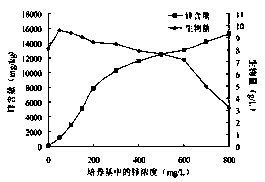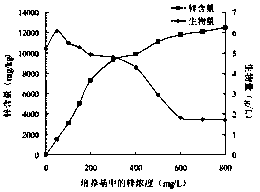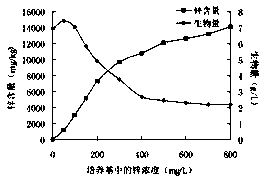A dry bacterium strain and its fermented dry bacterium mycelium zinc polysaccharide and its application
A technology of Zinc-enriched Dried Bacteria and Dried Bacteria, which is applied in the application field of Dried Bacteria Mycelia Zinc Polysaccharide and Dried Bacteria Mycelium Zinc Polysaccharide, which can solve the problems of poor effect, gastrointestinal irritation, and difficulty in absorption, etc.
- Summary
- Abstract
- Description
- Claims
- Application Information
AI Technical Summary
Problems solved by technology
Method used
Image
Examples
Embodiment 1
[0045] The acquisition of embodiment 1 stem bacteria strain
[0046] Collect 4 fresh fruiting bodies of D. spp. from different areas in Yunnan Province, disinfect the surface with 75% alcohol, rinse several times with sterile water, use sterilized tweezers to tear off small pieces of the internal tissue of D. spp. and inoculate them with chloramphenicol On the potato dextrose (PDA) medium plate, move it into a 24 ℃ incubator for cultivation. After the mycelium grows, it will be purified repeatedly until the pure culture of D. spp. is obtained.
[0047] Four strains of S. spp. were screened from 4 S. spp. fruiting bodies and named as TG-1, TG-2, TG-3 and TG-4 respectively.
Embodiment 2
[0048] Example 2 Analysis of Zinc-enriching Ability
[0049] Take 0.5 cm respectively 2 Dryingbacillus strains TG-1, TG-2, TG-3, and TG-4 were inserted into PDA liquid medium and cultured in a shaking table at 24°C for 7 days, and then transferred to PDA liquid containing different concentrations of zinc. In the medium (zinc concentration is 0, 50, 100, 150, 200, 300, 400, 500, 600, 700, 800 mg / L, ZnSO 4 ·7H 2 O), 5 repetitions for each gradient, 250 mL of liquid in a 500 mL Erlenmeyer flask, and shaking culture in a shaker at 24 °C for 10 days. After the fermentation, centrifuge (10000r / min, 10 min) to separate the mycelium of D. spp., and wash the mycelium with deionized water 3 times. The mycelium was dried in an oven at 55 ℃, and the biomass of the mycelium and the content of zinc in the mycelium were determined.
[0050] Figure 1~4 Respectively, TG-1, TG-2, TG-3, TG-4 fermentation medium zinc concentration and the relationship between mycelium biomass and zinc conte...
Embodiment 3
[0052] The zinc-rich liquid fermentation of embodiment 3 dried bacteria
[0053] Carry out fermenter culture experiments. ① Activation of bacteria. The bacteria TG-1, TG-2, TG-3, and TG-4 were respectively inoculated on the activated PDA medium plate, and cultured at 24 °C for 7 days. ② Seed cultivation. Take 0.5 cm respectively 2 The activated strain of D. spp. was inserted into zinc-rich PDA liquid medium (potato 200 g / L, glucose 20 g / L, magnesium sulfate 1 g / L, potassium dihydrogen phosphate 1.5 g / L, zinc concentration 150 mg / L , with ZnSO 4 ·7H 2 O), the liquid volume in a 500 mL Erlenmeyer flask was 300 mL, and then cultured in a shaker at 24 °C for 10 d. ③ Fermentation tank culture. Loading volume: 7.5 L; inoculum volume: 10 %; fermentation temperature: 24°C; stirring speed: 350 r / min; foam control: add two drops of defoamer after inoculation. ③ Determination of pH value and DO value during fermentation. The pH electrode and dissolved oxygen electrode are used t...
PUM
 Login to View More
Login to View More Abstract
Description
Claims
Application Information
 Login to View More
Login to View More - R&D
- Intellectual Property
- Life Sciences
- Materials
- Tech Scout
- Unparalleled Data Quality
- Higher Quality Content
- 60% Fewer Hallucinations
Browse by: Latest US Patents, China's latest patents, Technical Efficacy Thesaurus, Application Domain, Technology Topic, Popular Technical Reports.
© 2025 PatSnap. All rights reserved.Legal|Privacy policy|Modern Slavery Act Transparency Statement|Sitemap|About US| Contact US: help@patsnap.com



